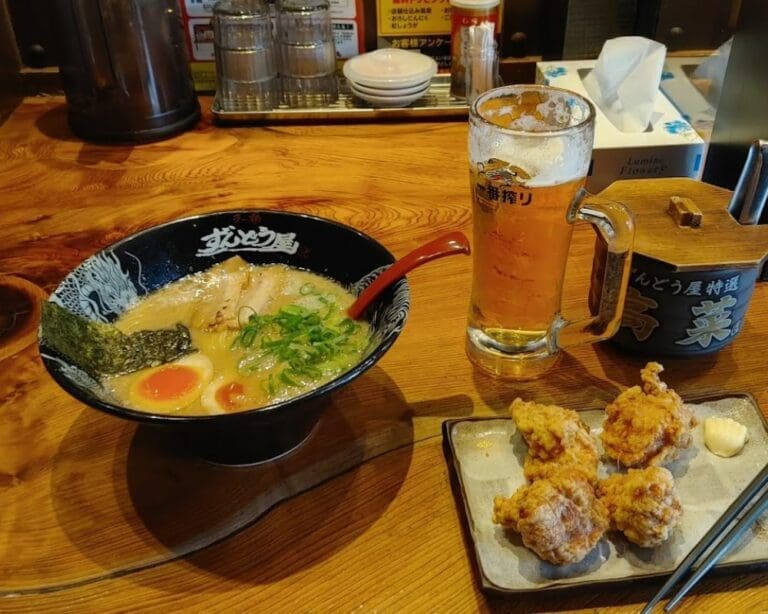30 unique things to do in Tokyo, Japan
Here are the best things to do in Tokyo with information on how to get there, entrance fees, tour prices, and more!
Tokyo is worth visiting because it is a city where tradition meets futuristic innovation, offering a unique blend of cultural experiences, technological wonders, culinary delights, and shopping extravaganzas.
Tokyo is also home to beautiful parks and gardens, historic temples and shrines, and world-class museums and galleries.

The range of available things to do in Tokyo is vast and varied, catering to all interests and ages. Tokyo offers an unparalleled experience for all types of travelers!
Tokyo is also famous for its pop culture, visible in Akihabara’s electronic and anime shops and the diverse fashion of Harajuku.
The cost of things to do in Tokyo can vary widely, offering options for both budget travelers and those looking to indulge in luxury experiences. Many of Tokyo’s attractions, such as its parks, temples, and some museums, are free or have a low entrance fee.
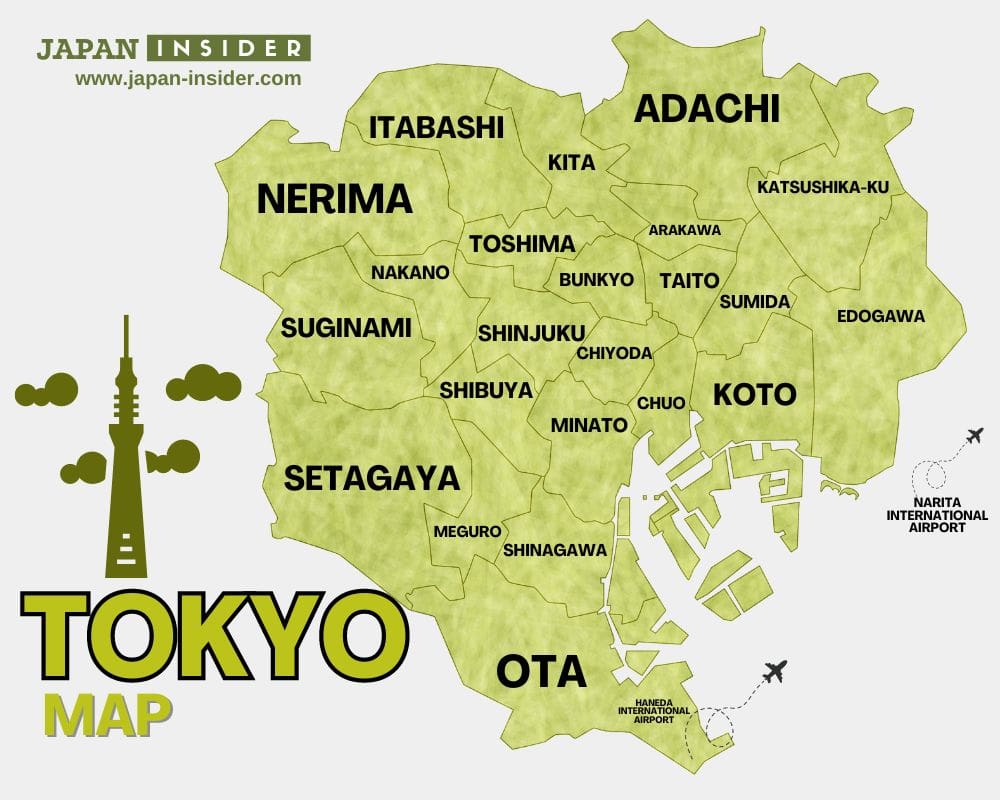
🎌 Recommended: The best things to do in Shinjuku, Tokyo
Here are the best things to do in Tokyo Japan, with information on how to get there, entrance fees, tour prices, and more!
1. Visit the Tokyo Skytree for Panoramic Views of the City
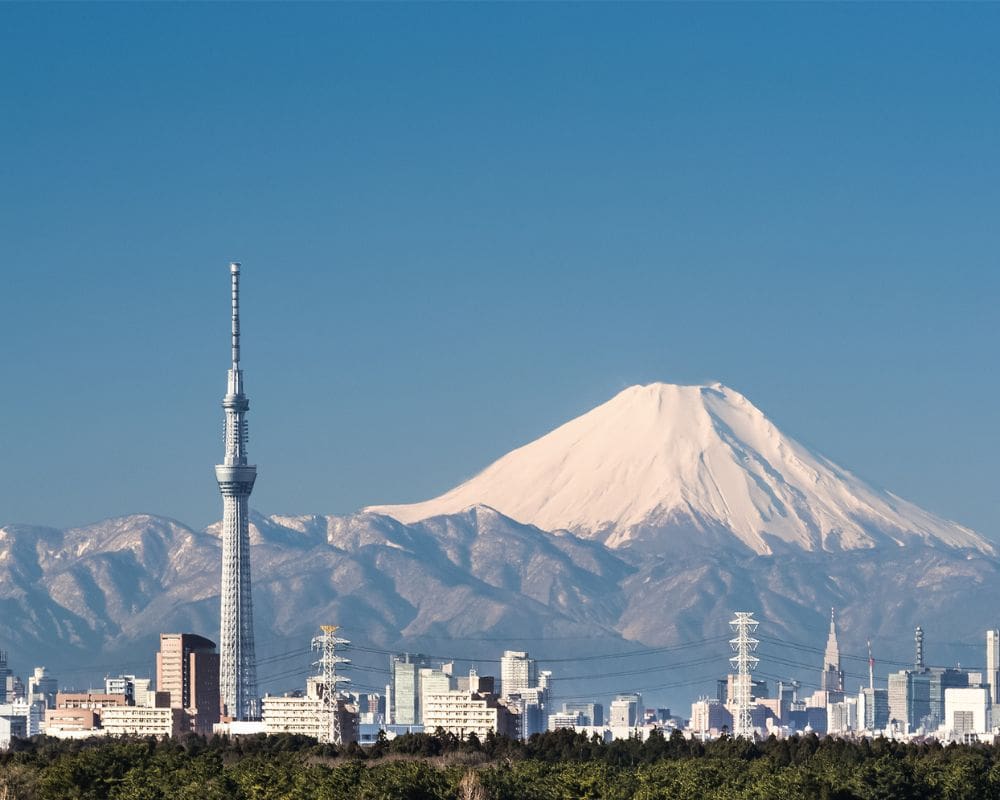
One of the most iconic things to do in Tokyo Japan, is visiting the Tokyo Skytree. Standing at 634 meters, it is the tallest structure in Japan and offers unparalleled views of the sprawling metropolis.
The Skytree serves as a television broadcasting tower and a popular tourist attraction, featuring observation decks and a shopping complex.
Access to the Tokyo Skytree is convenient via the Tokyo Skytree Station on the Tobu Skytree Line or Oshiage Station, accessible by multiple lines including the Asakusa, Hanzomon, and Keisei Oshiage Lines.
Entrance fees for the observation decks are approximately 2,060 yen ($14 USD) for the first observation deck and an additional fee for the higher deck. Tickets can be purchased on the day or in advance to avoid long waiting times.
The complex also houses a variety of shops and restaurants, making it a full-day destination. Visiting the Tokyo Skytree is worth it for the breathtaking views alone, offering a perspective on Tokyo that can’t be found anywhere else!
🗼 Travel Tip: Clear days offer the best visibility, sometimes extending as far as Mount Fuji on the horizon. Early mornings or weekdays can be quieter times to visit, providing a more relaxed experience.
2. Explore the Historic Senso-ji Temple in Asakusa
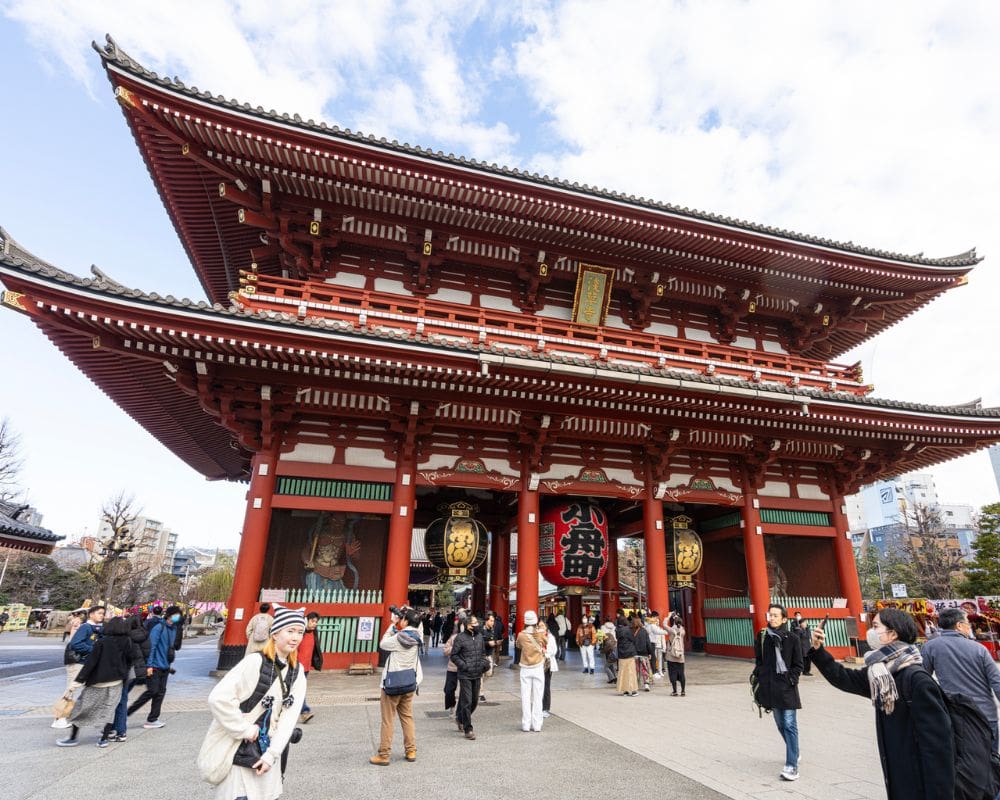
The historic Senso-ji Temple is a must-do when looking for things to do in Tokyo Japan. As Tokyo’s oldest temple, it draws visitors from around the world with its vibrant gates, stunning pagoda, and bustling market stalls lining Nakamise Street leading up to the temple.
The atmosphere is a blend of the spiritual and the commercial, offering a unique glimpse into traditional Japanese culture amidst the modern city.
Senso-ji is accessible via Asakusa Station, which is served by the Ginza and Asakusa Subway Lines, making it easily reachable from any part of Tokyo.
There is no entrance fee to enter Senso-ji Temple, making it a popular and accessible attraction for all visitors. The temple grounds are open 24 hours, though the main hall has specific opening hours, usually from early morning to early evening.
The temple’s rich history and beautiful architecture make it a worthwhile visit, providing a peaceful retreat from the city’s hustle and bustle. The opportunity to witness traditional Japanese rituals and the serene atmosphere of the temple grounds makes Senso-ji Temple worth visiting.
🍢 Travel Tip: Visit the nearby Nakamise Street for a variety of traditional Japanese souvenirs and snacks, perfect for picking up gifts or trying local delicacies.
3. Shop and Dine in the Bustling Shibuya Crossing Area

Shibuya Crossing is famed as one of the busiest pedestrian crossings in the world and a symbol of Tokyo’s dynamic energy.
The area around Shibuya Station is a hub for shopping, dining, and entertainment, making it a top destination for anyone looking to dive into the heart of Tokyo’s urban culture.
The crossing itself is an exhilarating experience, with hundreds of people crossing from all directions amidst the neon lights of Shibuya.
Accessing Shibuya Crossing is straightforward as it is located directly in front of Shibuya Station, which is served by the JR Yamanote Line, the Tokyo Metro lines, and private lines such as the Keio Inokashira and Tokyu Toyoko lines.
There are no entrance fees to walk through Shibuya Crossing. The area around the crossing boasts numerous shops, restaurants, and entertainment venues, catering to all tastes and budgets.
The energy and atmosphere of Shibuya Crossing make it a must-visit. It embodies the modern, fast-paced, and vibrant spirit of Tokyo. The area’s plethora of dining and shopping options ensures that everyone finds something to love.
A unique travel tip for Shibuya Crossing is to view it from one of the surrounding buildings. The Starbucks in the Tsutaya building offers a great vantage point to watch the crossing’s organized chaos without being in the middle of it.
4. Experience the Vibrant Harajuku District, Known for Its Unique Street Fashion
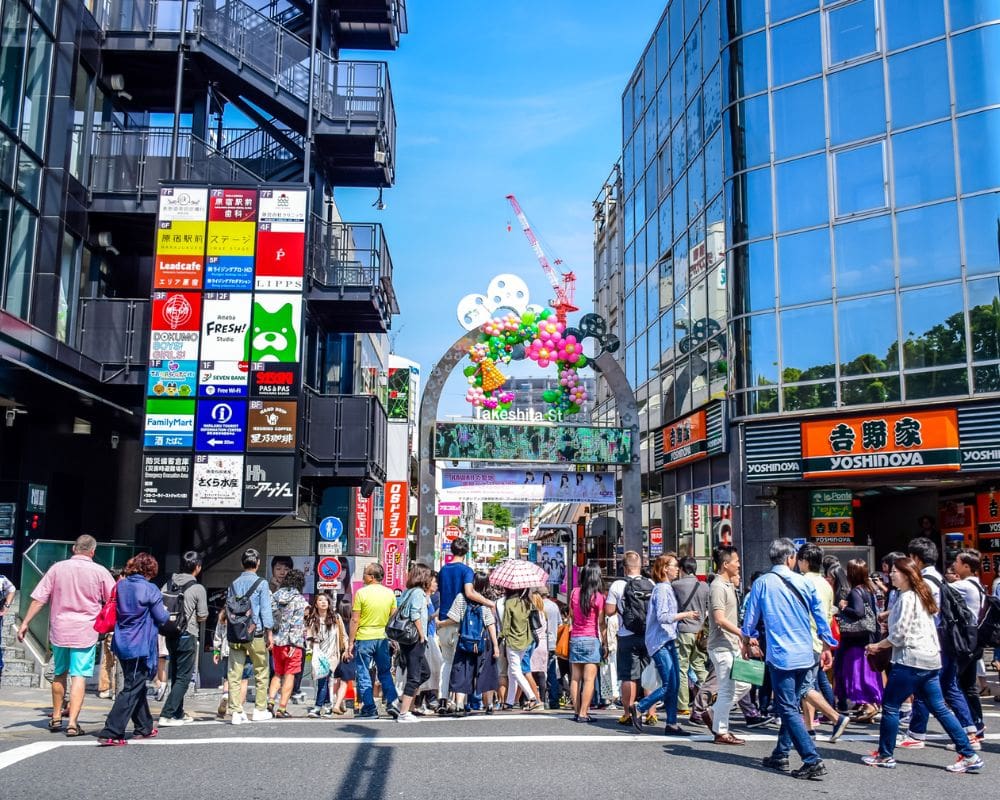
Harajuku, particularly Takeshita Street, is the heart of Japan’s youth culture and street fashion, making it an exciting place for those exploring things to do in Tokyo Japan.
This area is famous for its eclectic fashion shops, trendy boutiques, and colorful cafes, reflecting the creative and often whimsical style of Tokyo’s youth. Harajuku has become synonymous with Japan’s unique and influential fashion scene, attracting both locals and tourists alike.
Takeshita Street is just a short walk from Harajuku Station, which is accessible via the JR Yamanote Line, making it easily reachable from central Tokyo.
There are no entrance fees to explore Harajuku’s streets, and the area offers a wide range of shopping and dining options to suit all budgets. The district is particularly busy on weekends when young people come to showcase their latest outfits.
Harajuku is worth visiting for its vibrant atmosphere and unique fashion culture. It offers a glimpse into the diverse and dynamic youth culture of Japan, making it a fascinating experience for visitors.
👘 Travel Tip: Visit the side streets off Takeshita Street. These lesser-known lanes are filled with boutique shops and cafes, offering a quieter and more unique shopping experience away from the main street’s crowds.
5. Walk Through the Serene Meiji Shrine and Its Surrounding Forest

The Meiji Shrine, dedicated to Emperor Meiji and Empress Shoken, is an oasis of tranquility in the bustling city of Tokyo. Surrounded by a dense forest, this Shinto shrine offers a peaceful retreat with its expansive grounds and walking paths.
The shrine complex celebrates the spirits of the emperor and empress, with traditional architecture and serene gardens.
Located near Harajuku Station on the JR Yamanote Line and Meiji-jingumae Station on the Tokyo Metro Chiyoda and Fukutoshin Lines, the shrine is easily accessible from anywhere in Tokyo.
There is no entrance fee to the shrine grounds, which are open from sunrise to sunset. The surrounding Yoyogi Park adds to the area’s appeal, offering additional green space for relaxation and leisure.
Visiting the Meiji Shrine is worth it for the opportunity to experience Japan’s natural beauty and spiritual culture within the urban environment of Tokyo. The contrast between the tranquil shrine and the nearby bustling Harajuku district highlights the diverse experiences Tokyo offers.
⛩️ Travel Tip: Participate in a traditional Shinto activity, such as writing a wish on an ema (wooden plaque) and hanging it at the shrine.
6. Spend the Day at Tokyo Disneyland or Tokyo DisneySea

Tokyo Disneyland and Tokyo DisneySea are must-visit destinations for families and Disney enthusiasts exploring things to do in Tokyo Japan.
Tokyo Disneyland offers a classic Disney experience with beloved characters and rides, while Tokyo DisneySea features unique maritime-themed attractions and shows. Both parks provide a magical experience with their meticulously themed areas, parades, and entertainment.
The parks are located in the Tokyo Disney Resort in Urayasu, Chiba Prefecture, just outside Tokyo. Access is easy via the JR Keiyo Line or Musashino Line to Maihama Station, from where it’s a short walk to the entrance of both parks.
Tickets can be purchased in advance online or at the park entrances, with prices varying by season and type of pass. It’s recommended to check the official website for specific ticket options and prices.
Spending a day at either Tokyo Disneyland or Tokyo DisneySea is worth it for the high-quality attractions, shows, and overall atmosphere of joy and magic. These parks stand out for their attention to detail, cleanliness, and unique attractions that can’t be found in other Disney parks around the world.
🎡 Travel Tip: Download the park’s official app before your visit. The app provides real-time information on wait times for attractions, show schedules, and can even let you make dining reservations, helping you maximize your time at the park.
7. Visit the Tokyo Tower and Its Observation Decks
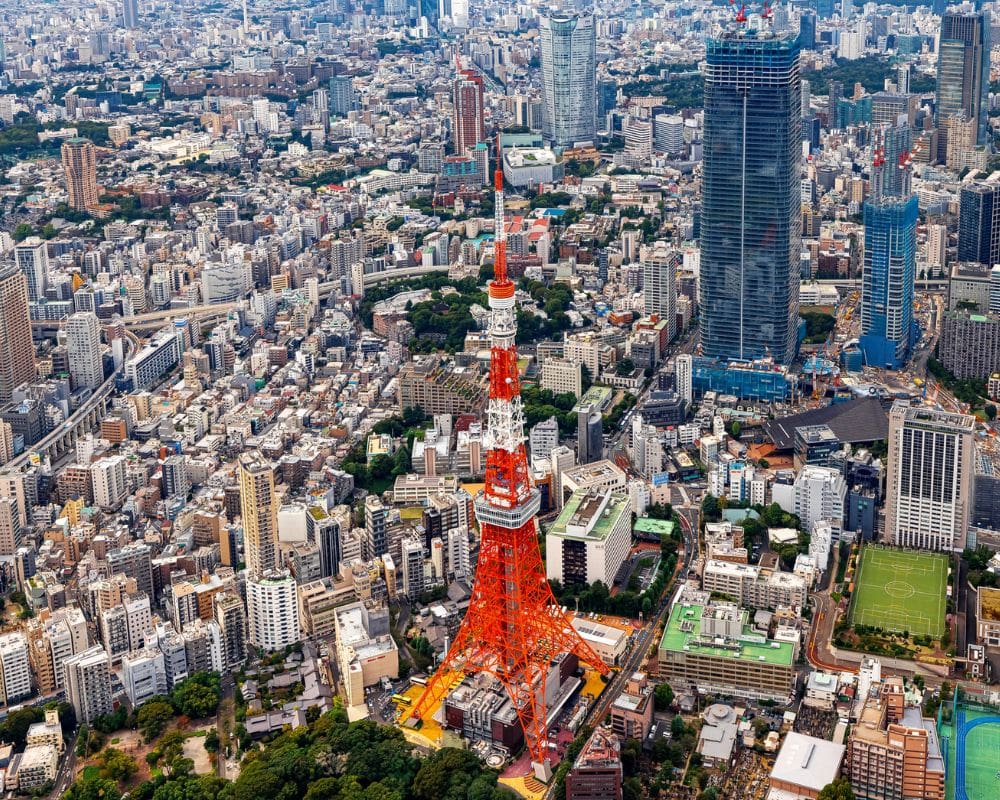
The Tokyo Tower, with its red and white lattice structure, is a symbol of Japan’s post-war rebirth as a major economic power and a popular spot for those seeking things to do in Tokyo Japan.
This 333-meter tower offers visitors panoramic views of Tokyo from its two observation decks. The Main Observatory is at 150 meters, while the Top Deck sits at 250 meters, providing breathtaking vistas of the city and beyond.
Located in the Minato district, Tokyo Tower is easily accessible by public transport: Akabanebashi Station on the Oedo Subway Line is the nearest, with a 5-minute walk to the tower.
Entrance fees are required for both observation decks, with the option to purchase a ticket for the Main Observatory alone or a combo ticket that includes the Top Deck.
Visiting Tokyo Tower is worth it not only for the views but also for the tower’s historical significance and architecture. It’s a beloved landmark that offers a different perspective on Tokyo, especially beautiful at night when the city lights sparkle.
8. Explore the Imperial Palace and Its Beautiful East Gardens

The Imperial Palace, with its historic buildings and the beautiful East Gardens, is a serene escape in the heart of Tokyo. As the primary residence of the Emperor of Japan, the palace is surrounded by moats and massive stone walls, offering a glimpse into the country’s rich history.
The East Gardens are part of the inner palace area and are open to the public, showcasing meticulously maintained Japanese gardens, historic structures, and the remnants of Edo Castle.
The Imperial Palace is centrally located in Tokyo, with several nearby stations including Tokyo Station, Otemachi Station, and Nijubashimae Station.
Entrance to the East Gardens is free, and they are open to the public most days except Mondays and Fridays. Guided tours of the palace grounds are available, but require advance reservation through the Imperial Household Agency’s website.
Visiting the Imperial Palace and its East Gardens is worth it for those interested in Japanese history and culture. The gardens offer a peaceful retreat from the bustling city and a chance to appreciate traditional Japanese landscape design.
🎎 Travel Tip: Check the calendar for public events. Several times a year, the Imperial Family makes public appearances, and the palace grounds may host special events, offering a rare opportunity to witness Japanese imperial traditions.
9. Check Out the teamLab Borderless Digital Art Museum

teamLab Borderless is a revolutionary digital art museum in Tokyo, offering an immersive experience where art and technology meet.
This museum features interactive installations that blur the lines between the art and viewers, creating a seamless world of constantly evolving light and sound.
The exhibits are designed to encourage exploration and interaction, ensuring that no two visits are exactly the same.
Located in the Odaiba area, teamLab Borderless is accessible via the Yurikamome Line to Aomi Station or the Rinkai Line to Tokyo Teleport Station.
Tickets should be purchased in advance due to high demand. The museum’s popularity means that entry times can be crowded, so booking an early time slot or visiting on a weekday can enhance the experience.
Visiting teamLab Borderless is worth it for its unique approach to art, offering a sensory experience that is both engaging and thought-provoking. The museum’s dynamic installations are a testament to the creative possibilities of digital technology.
👘 Travel Tip: Wear comfortable shoes and clothes that you don’t mind getting a bit dirty. Some installations involve interactive elements where you might sit or lie down, and comfortable attire will enhance your enjoyment of the museum.
10. Shop in the Luxury District of Ginza
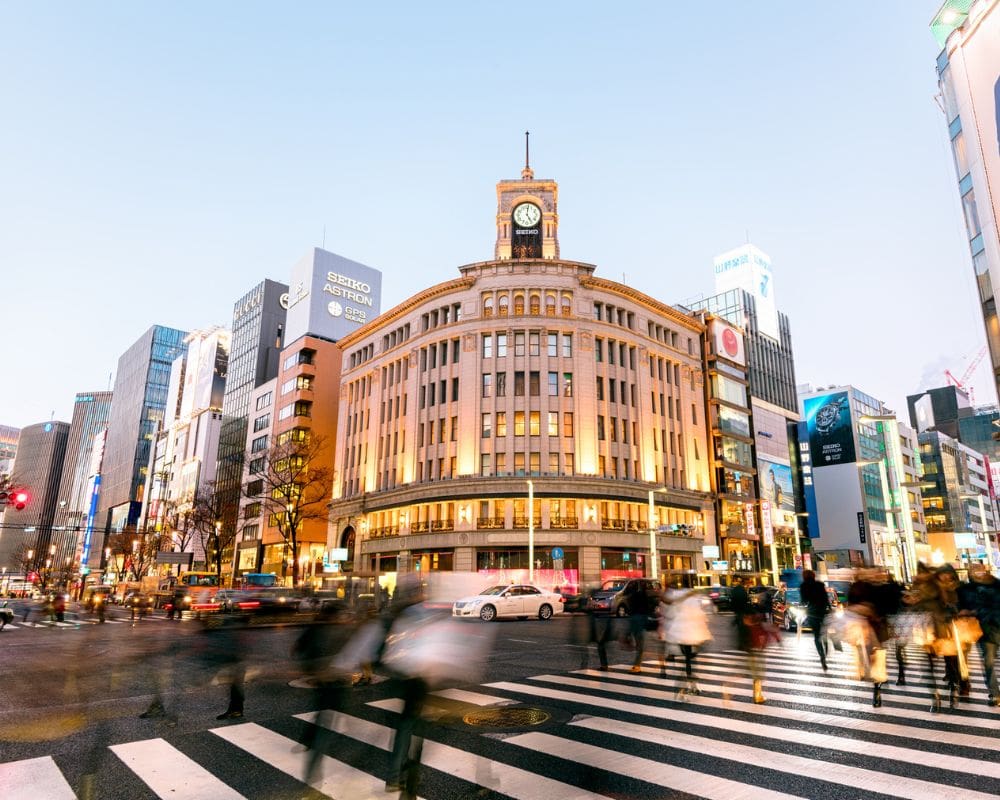
Ginza is Tokyo’s premier shopping district, known for its luxury boutiques, high-end department stores, and exclusive restaurants.
This area combines the traditional with the modern, offering not only shopping but also cultural experiences like theaters, galleries, and traditional tea houses.
Ginza’s wide avenues are home to many flagship stores of international fashion brands, making it a paradise for fashion enthusiasts.
Ginza is easily accessible by public transport, with Ginza Station being the main hub, connected by the Marunouchi, Ginza, and Hibiya Subway Lines.
Many stores in Ginza are open daily, though hours may vary. While shopping in Ginza can be expensive, window shopping and exploring the area’s architectural beauty is free.
Visiting Ginza is worth it for those who appreciate the finer things in life. The district offers a glimpse into Tokyo’s luxury lifestyle and provides a sophisticated shopping and dining experience that is hard to match.
🏯 Travel Tip: Explore the Ginza neighborhood on Sundays when the main street, Chuo-dori, becomes a pedestrian paradise. This is a great time to enjoy the district at a slower pace, take photos without the worry of cars, and experience street performances and pop-up events.
11. Discover the Edo-Tokyo Museum and Learn About Tokyo’s History
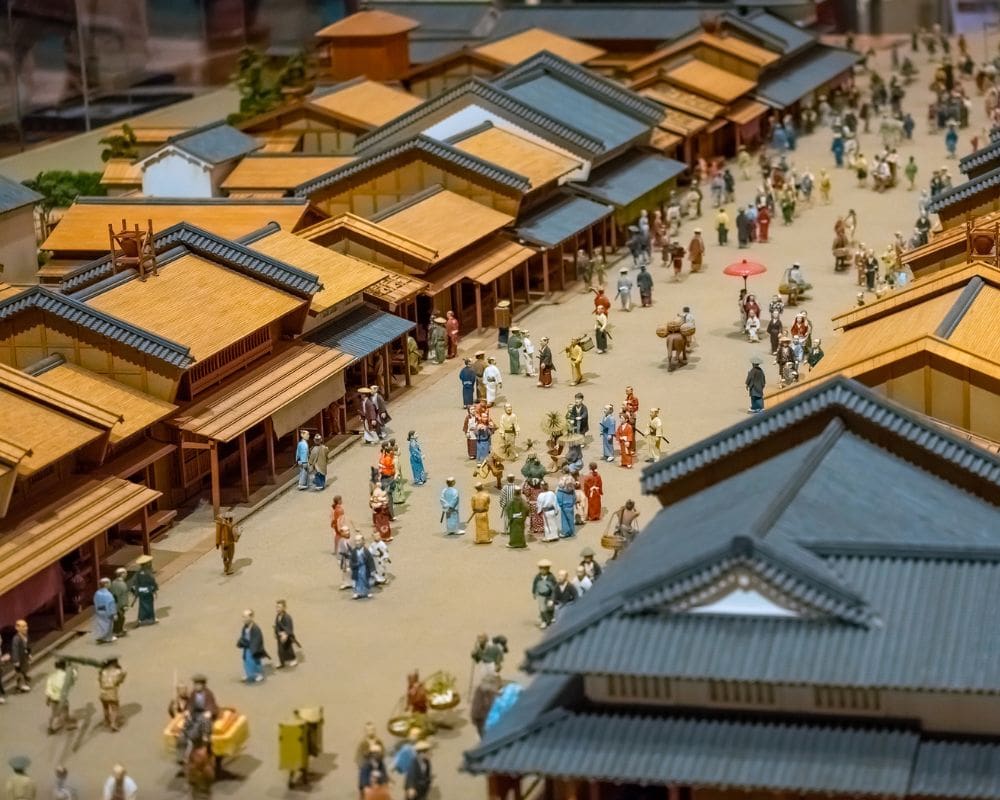
The Edo-Tokyo Museum is a fascinating destination for those interested in exploring the rich history of Tokyo Japan. This museum offers an in-depth look at Tokyo’s transformation from the Edo period to the modern metropolis it is today.
Through a variety of exhibits, including detailed models and life-size replicas, visitors can immerse themselves in the life of Tokyo’s past and present.
Located in the Ryogoku area, the museum is easily accessible via the JR Sobu Line to Ryogoku Station or the Toei Oedo Line, also to Ryogoku Station.
The entrance fee is reasonably priced, with discounts available for students and seniors, and free entry for children under elementary school age. The museum offers guided tours in English, providing valuable insights into the exhibits and the history of Tokyo.
Visiting the Edo-Tokyo Museum is worth it for its comprehensive overview of Tokyo’s evolution. It provides a deeper understanding of the city’s culture and the significant events that have shaped its history.
🎴 Travel Tip: Check for special exhibitions and limited-time events, which often focus on specific aspects of Tokyo’s culture or history.
12. Visit the Ueno Zoo and Adjacent Ueno Park best things to do in Tokyo with kids

Ueno Zoo, located within the expansive Ueno Park, is Japan’s oldest zoo and offers a delightful experience for animal lovers and families looking for things to do in Tokyo Japan.
The zoo is home to a wide variety of species, including the beloved giant pandas, making it a popular attraction. Ueno Park, surrounding the zoo, is one of Tokyo’s largest and most beautiful public parks, famous for its cherry blossoms in spring.
The zoo is easily accessible from Ueno Station, served by multiple JR and Tokyo Metro lines. Entrance fees are affordable, making it a great value destination for visitors.
The zoo’s opening hours vary by season, so it’s recommended to check their official website before visiting. Ueno Park is free to enter and offers additional attractions, including museums and temples, making it a full-day destination.
Visiting Ueno Zoo and strolling through Ueno Park is worth it for the opportunity to connect with nature and enjoy outdoor activities in the heart of Tokyo. The area offers a peaceful escape from the bustling city and a chance to learn about wildlife conservation.
🐼 Travel Tip: Visit early in the morning, especially to see the pandas when they are most active. Additionally, exploring Ueno Park during cherry blossom season offers a spectacular experience with breathtaking views of the blooms.
13. Wander Through the Tsukiji Outer Market for Fresh Seafood
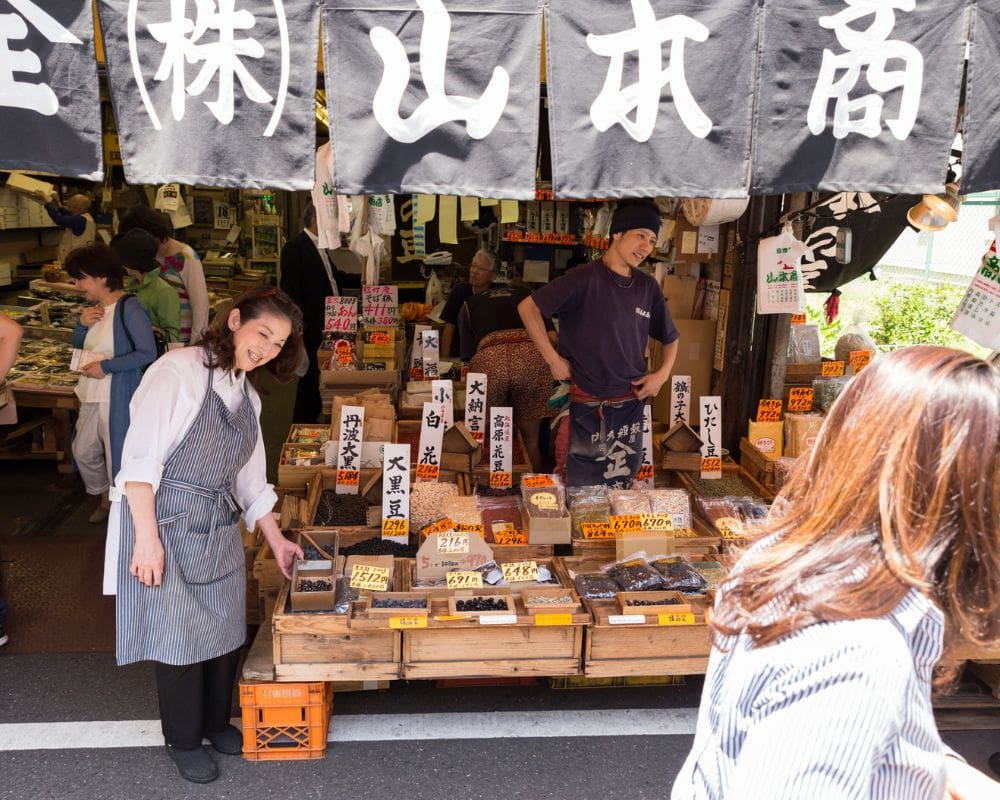
The Tsukiji Outer Market is a must-visit for food enthusiasts exploring things to do in Tokyo Japan.
Though the inner wholesale market has moved to Toyosu, Tsukiji’s Outer Market continues to thrive, offering an array of fresh seafood, produce, and a variety of Japanese food stalls and restaurants.
This bustling market provides a glimpse into the culinary heart of Tokyo, where visitors can sample fresh sushi, sashimi, and other Japanese delicacies.
Located just a short walk from Tsukiji Shijo Station on the Oedo Subway Line or Tsukiji Station on the Hibiya Subway Line, the market is easily accessible.
There is no entrance fee to wander through the market’s lanes, making it a budget-friendly activity. The market operates mainly in the morning and early afternoon, so it’s best to visit early to experience it fully.
Exploring Tsukiji Outer Market is worth it for the chance to taste some of the freshest seafood in the world and to experience the lively atmosphere of a traditional Japanese market.
🎣 Travel Tip: Try breakfast or an early lunch at one of the local sushi bars. These establishments often serve the freshest fish, caught and delivered the same morning, offering an authentic and unforgettable dining experience.
14. Experience a Sumo Tournament at Ryogoku Kokugikan: unique things to do in Tokyo Japan
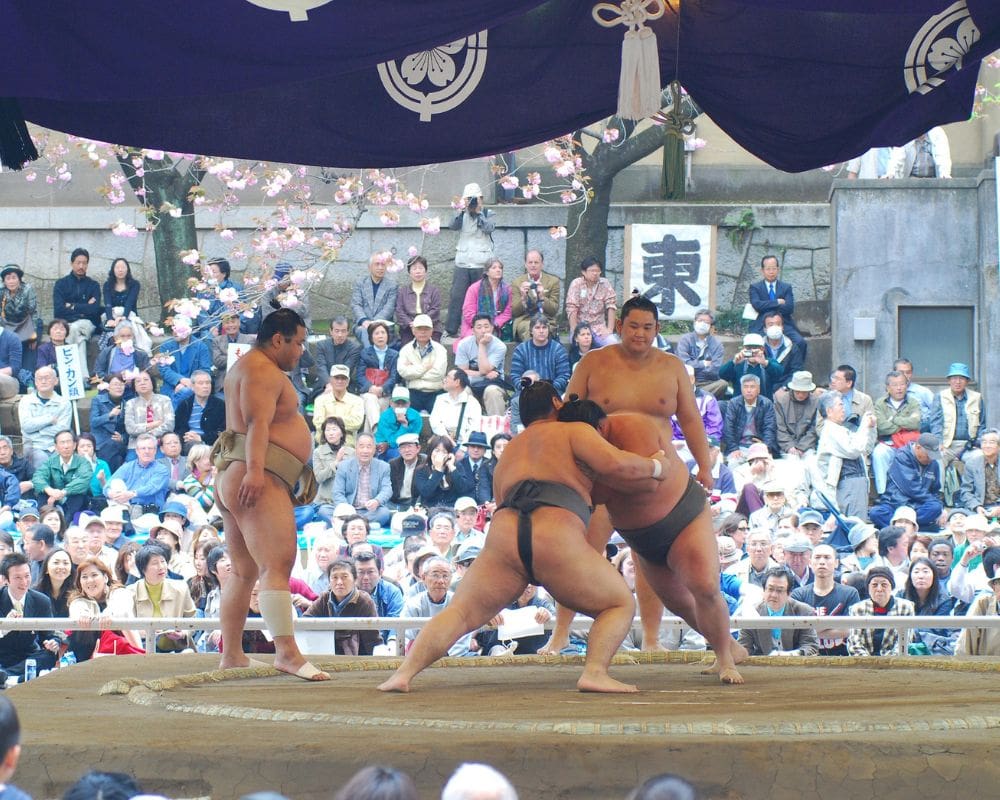
Attending a sumo tournament at Ryogoku Kokugikan is a unique cultural experience and a highlight for visitors seeking authentic things to do in Tokyo Japan.
Ryogoku Kokugikan is Tokyo’s primary sumo hall, hosting major tournaments that draw crowds from all over Japan and the world. Sumo, Japan’s national sport, offers a fascinating insight into Japanese tradition and the country’s ancient sporting culture.
Ryogoku Kokugikan is located near Ryogoku Station, accessible via the JR Sobu Line or the Toei Oedo Subway Line.
Tickets for sumo tournaments vary in price depending on the seat, with advance purchase strongly recommended due to the popularity of the events. Tournaments are held three times a year in Tokyo, in January, May, and September, each lasting 15 days.
Experiencing a sumo tournament is worth it for the intense atmosphere, the ceremonial traditions, and the opportunity to witness the strength and skill of the sumo wrestlers up close.
🤼♀️ Travel Tip: Visit on a weekday during the early days of the tournament when the arena is less crowded. This can offer a better chance to get closer seats and enjoy the matches in a more intimate setting.
15. Enjoy the Nightlife in the Roppongi District
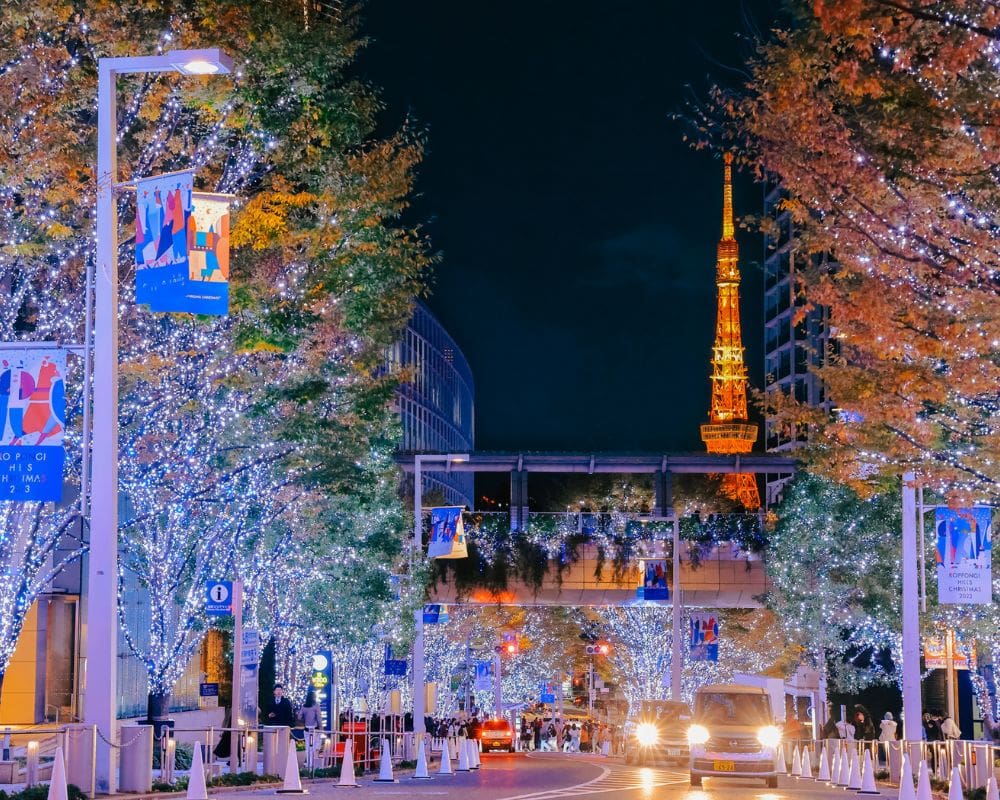
Roppongi is renowned for its vibrant nightlife and is a popular destination for locals and tourists looking for things to do in Tokyo Japan, after dark.
The district offers a wide range of entertainment options, from upscale bars and clubs to live music venues and international restaurants. Roppongi is also home to several art museums and galleries, making it a cultural hub by day and a lively entertainment district by night.
Roppongi is easily accessible via the Tokyo Metro Hibiya Line or the Toei Oedo Line, with Roppongi Station serving as the main access point.
Clubs and bars in Roppongi may have cover charges. The area is safe, but visitors should remain aware of their surroundings, especially late at night.
The nightlife in Roppongi is worth experiencing for its diversity and the opportunity to mingle with both locals and travelers. The district offers something for every taste, whether you’re looking for a quiet bar, a bustling nightclub, or live entertainment.
16. Visit the Mori Art Museum in Roppongi Hills
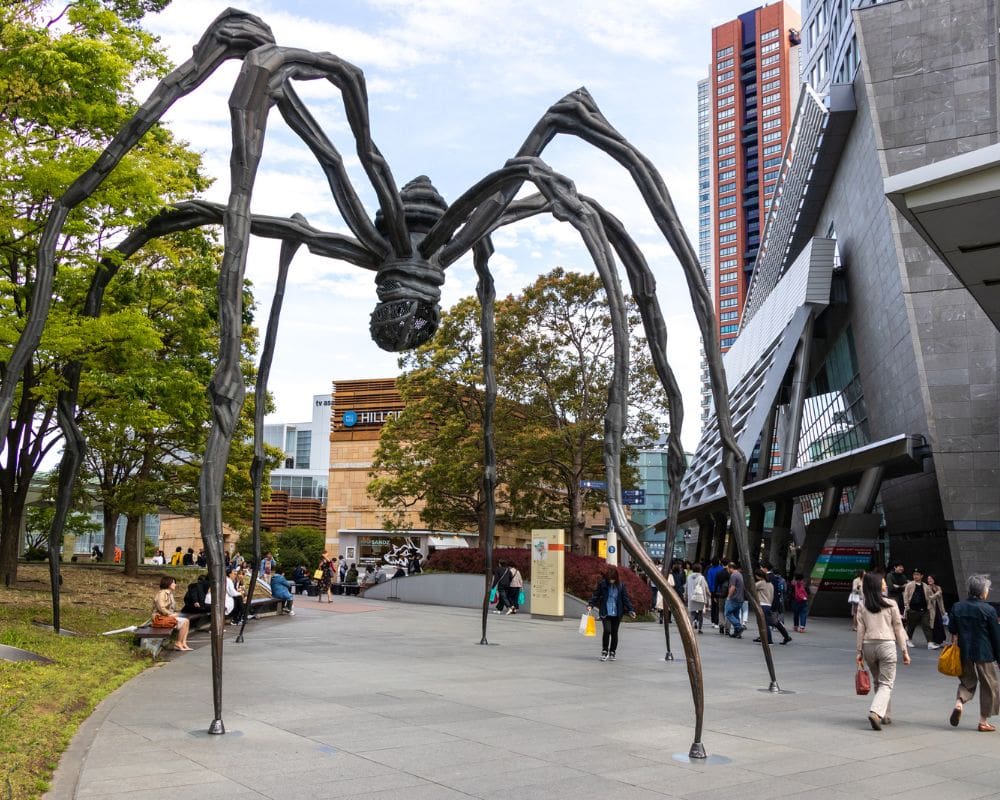
The Mori Art Museum in Roppongi Hills is one of the top things to do in Tokyo Japan, for art enthusiasts and those interested in contemporary culture.
Located in the Roppongi Hills Mori Tower, the museum features cutting-edge exhibitions that span a variety of mediums, from painting and sculpture to fashion and architecture.
The museum aims to present contemporary art within the context of a global perspective. The Mori Art Museum is easily accessible via the Tokyo Metro Hibiya Line, getting off at Roppongi Station.
Admission fees vary depending on the exhibition but generally include access to the Tokyo City View observation deck, providing stunning panoramic views of the city. The museum stays open until 10:00 pm on most days, making it a perfect evening activity.
The Mori Art Museum in Roppongi is worth visiting not only for its diverse and dynamic exhibitions but also for the breathtaking views of Tokyo it offers from the observation deck. It’s a cultural experience that combines art with the beauty of the city’s skyline.
17. Take a Boat Cruise on the Sumida River

Taking a boat cruise on the Sumida River is an enjoyable and relaxing way to see Tokyo from a different perspective.
The river flows through the city and offers views of famous landmarks like the Tokyo Skytree, Asahi Beer Hall, and the historic bridges that span the waterway.
Various cruise options range from traditional yakatabune boats to modern water buses, providing a unique experience of Tokyo’s scenery and skyline.
Cruises can be boarded at several points along the river, including Asakusa and Hinode Pier, with access from nearby subway and train stations.
Ticket prices vary depending on the length of the cruise and the type of boat but are generally affordable for an hour-long journey. Some cruises offer dining options, making for a memorable meal on the water.
A boat cruise on the Sumida River is worth it for the peaceful break from the bustling city streets and the unique views of Tokyo’s blend of old and new architecture.
🌇 Travel Tip: Time your trip around sunset or in the evening when Tokyo’s skyline lights up. This timing offers a magical view of the city illuminated against the night sky.
18. Explore the Akihabara District, Famous for Electronics and Anime
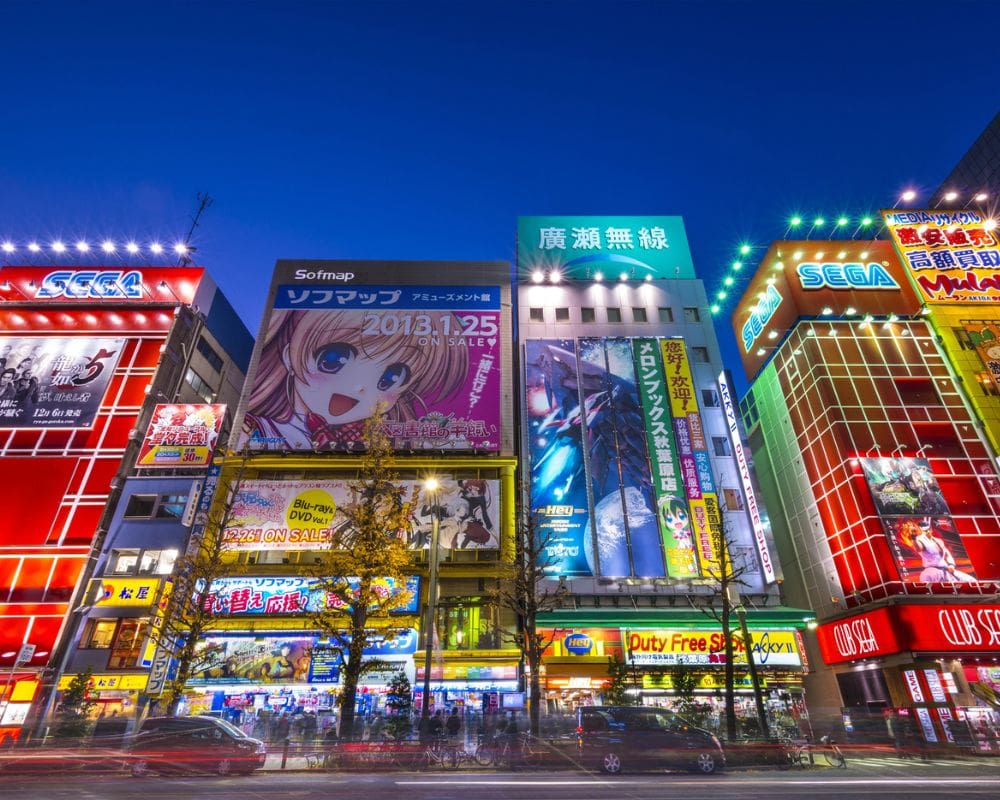
Akihabara, also known as “Electric Town,” is a vibrant district in Tokyo Japan, renowned for its vast selection of electronics shops, anime and manga stores, and otaku culture.
The area is a paradise for fans of video games, anime, and gadgets, featuring everything from the latest high-tech products to rare collectibles and themed cafes. The area is most lively during the weekend when many stores have special offers and events.
Akihabara is easily accessible via Akihabara Station, which is served by the JR Yamanote, Keihin-Tohoku, and Chuo lines, as well as the Tokyo Metro Hibiya Line.
Visiting Akihabara is worth it for the immersive experience of Japan’s contemporary pop culture and the chance to find unique items not available anywhere else in the world.
🤎 Travel Tip: Visit a maid cafe, where waitresses dressed in maid costumes serve food and perform songs. It’s a quintessential Akihabara experience that embodies the district’s unique blend of modern culture and entertainment.
19. Stroll Through Shinjuku Gyoen National Garden

Shinjuku Gyoen National Garden is a vast and serene park in the heart of Tokyo, Japan, offering a peaceful escape from the city’s hustle and bustle. The garden blends three distinct styles: traditional Japanese, formal French, and English Landscape.
It’s famous for its cherry blossoms in spring, chrysanthemums in autumn, and lush greenery year-round, making it a perfect spot for nature lovers and those seeking a tranquil retreat.
The garden is a short walk from Shinjuku Station, accessible via the JR Yamanote Line and several other subway lines.
A small entrance fee is required, making it an affordable way to enjoy one of Tokyo’s most beautiful green spaces. Shinjuku Gyoen is open every day except Mondays and during the New Year holidays, offering a refreshing outdoor experience in all seasons.
Shinjuku Gyoen National Garden is worth visiting for the beautifully maintained gardens and the opportunity to see traditional Japanese garden design up close. It’s a breath of fresh air amid Tokyo’s urban landscape.
🧺 Travel Tip: Bring a picnic and enjoy a meal in the English garden area of Shinjuku Gyoen National Garden. This is one of the few parks in Tokyo where picnicking is allowed.
20. Experience the Odaiba Area and Its Futuristic Attractions

Odaiba is a man-made island in Tokyo Bay, known for its futuristic architecture, entertainment complexes, and stunning views of the Rainbow Bridge and Tokyo skyline.
The area offers a wide range of activities, from shopping at diverse malls like DiverCity Tokyo Plaza to relaxing at Oedo-Onsen Monogatari, a hot springs theme park. Odaiba is also home to the iconic Statue of Liberty replica, providing a unique photo opportunity against the backdrop of the city.
Accessible via the Yurikamome Line from Shimbashi Station to Daiba Station or the Rinkai Line to Tokyo Teleport Station, Odaiba is easy to reach from central Tokyo.
Most attractions in Odaiba are free to enter, though some, like the onsen theme park, charge admission fees. The area is particularly beautiful at night when the Rainbow Bridge is illuminated.
Visiting Odaiba is worth it for the blend of leisure, shopping, and entertainment options in a scenic waterfront setting. The area’s modern attractions and relaxed atmosphere make it a popular destination for both locals and tourists.
🌉 Travel Tip: Visit the teamLab Borderless museum in the evening and then enjoy the illuminated Rainbow Bridge and Tokyo skyline at night. This combination offers a full day of futuristic experiences followed by breathtaking night views.
21. Visit the Ghibli Museum in Mitaka
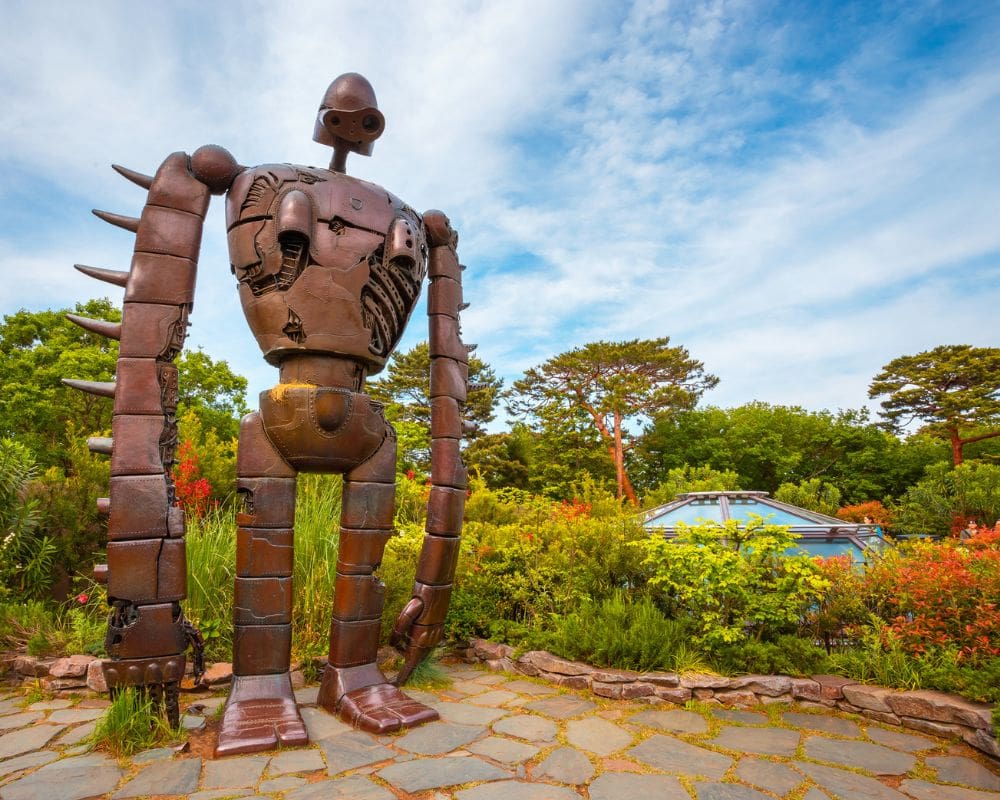
The Ghibli Museum in Mitaka is a magical destination for fans of Studio Ghibli films and those interested in animation. This enchanting museum offers a behind-the-scenes look at the creation of beloved films like “My Neighbor Totoro,” “Spirited Away,” and “Ponyo.”
The museum’s whimsical design, interactive exhibits, and exclusive short films provide a unique insight into the art and imagination of Hayao Miyazaki and Studio Ghibli.
Located in the western Tokyo suburb of Mitaka, the museum is accessible by train to Mitaka Station and then a pleasant 15-minute walk or a short bus ride.
Tickets must be purchased in advance through designated reservation systems and are not sold at the museum. This system helps manage visitor numbers and ensures a pleasant experience for all guests.
Visiting the Ghibli Museum is worth it for the opportunity to dive into the magical world of Studio Ghibli. The museum’s intimate and immersive approach invites visitors into the heart of the studio’s creative process.
🌺 Travel Tip: Don’t miss Ghibli Museum’s rooftop garden, where you can see a life-sized statue of the robot soldier from “Castle in the Sky,” offering a charming photo opportunity and a moment of reflection amidst the museum’s wonders.
22. Explore the Fashionable Omotesando Avenue
Omotesando Avenue is a must-visit for those seeking things to do in Tokyo Japan, that blend high fashion, architecture, and culture. Known as Tokyo’s Champs-Élysées, this broad, tree-lined avenue is home to a myriad of luxury brand shops, chic boutiques, and trendy cafes.
The architecture here is just as captivating, with many buildings designed by world-renowned architects, making it a stylish destination for fashionistas and design enthusiasts alike.
Omotesando is easily accessible via the Tokyo Metro, with Omotesando Station serving as the main gateway to the avenue. The area is particularly beautiful during the Christmas season when spectacular light displays add to the festive ambiance.
Visiting Omotesando Avenue is worth it for the exquisite blend of fashion, architecture, and street culture. It’s a place where Tokyo’s modernity, creativity, and elegance converge.
🍱 Travel Tip: Explore the side streets and alleys off the main avenue. These hidden gems are filled with unique boutiques, cozy cafes, and lesser-known galleries, offering a more intimate shopping and dining experience away from the main thoroughfare.
23. Visit the Tokyo National Museum in Ueno
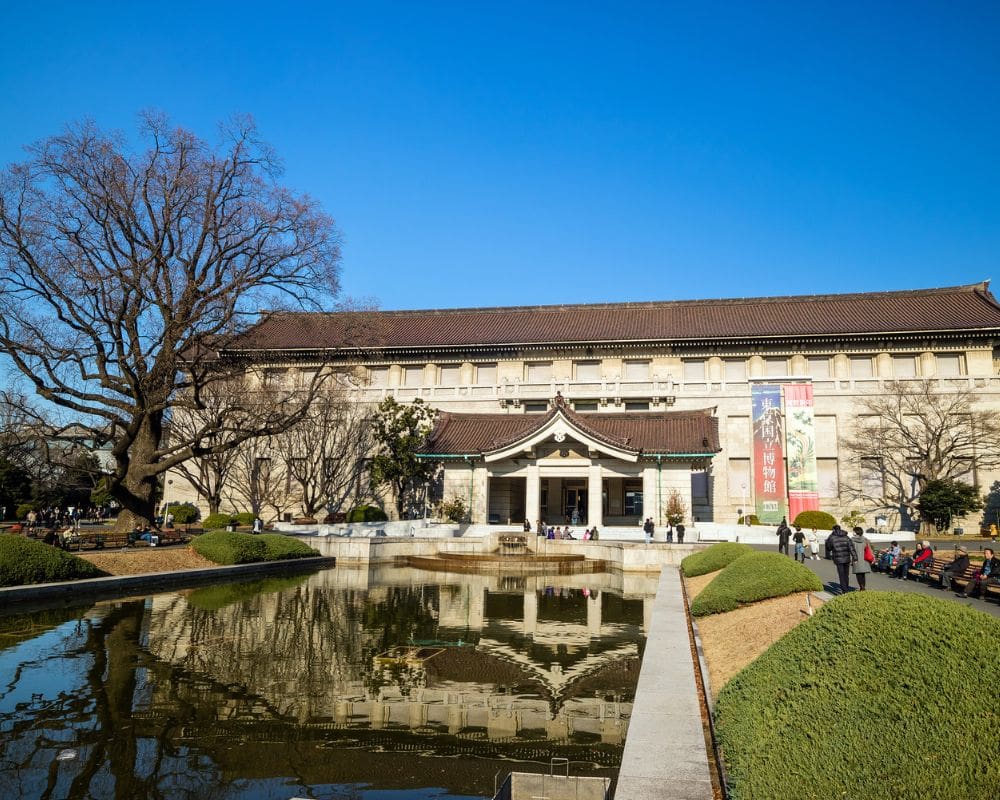
The Tokyo National Museum, located in the vibrant Ueno Park, is a treasure trove for those interested in delving into Japan’s rich history and diverse cultures.
As the oldest and largest museum in Japan, it houses an extensive collection of art and archaeological artifacts from Japan and other Asian countries.
The museum’s exhibits range from ancient pottery and samurai armor to delicate silk kimonos and Buddhist sculptures, offering a comprehensive overview of Asian heritage.
The museum is easily accessible from Ueno Station, which is served by JR lines and the Tokyo Metro.
An admission fee is required, but it grants access to all the permanent exhibitions and the beautiful museum grounds. The museum also hosts special exhibitions throughout the year, which may require an additional fee.
Visiting the Tokyo National Museum is worth it for the opportunity to see some of the finest examples of Japanese and Asian art in one place. The museum’s vast collection and serene setting make it a cultural and educational highlight of any Tokyo itinerary.
🏯 Travel Tip: Tokyo National Museum has free English-language tours. These tours provide valuable insights into the significance and history of the museum’s key pieces, enhancing the overall experience.
24. Walk Across the Rainbow Bridge
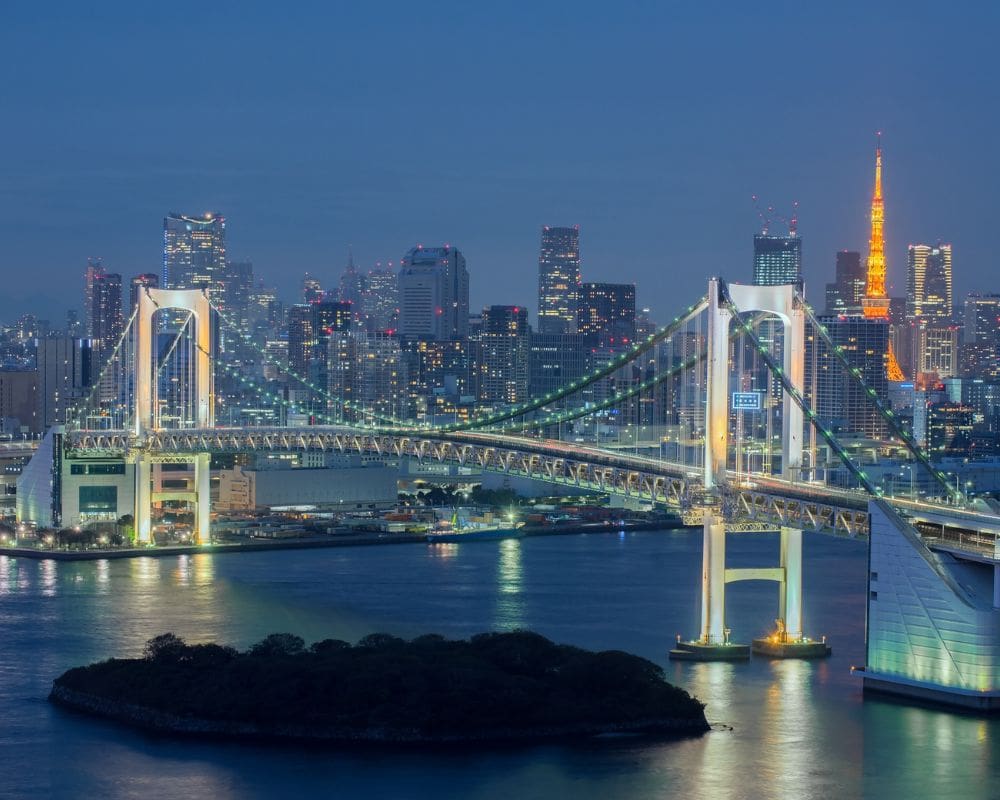
The Rainbow Bridge offers a unique and scenic way to experience Tokyo’s waterfront and skyline. The bridge spans Tokyo Bay, connecting Shibaura Pier with the Odaiba waterfront development.
Pedestrians can choose between two walkways on the north and south sides of the bridge, each offering different views of the city and bay. The walk across the bridge is an excellent opportunity to take in panoramic views of Tokyo Tower, the Tokyo skyline, and Odaiba.
The pedestrian walkways on the Rainbow Bridge are accessible from Shibaura Pier and Odaiba, with nearby access from Tamachi Station (JR lines) on the Shibaura side and Odaiba Kaihin Koen Station (Yurikamome Line) on the Odaiba side.
The walk is free of charge, and the bridge is open to pedestrians during specific hours, usually from early morning until late evening.
The Rainbow Bridge is worth it for the breathtaking views and the experience of seeing Tokyo from a different vantage point. It’s a peaceful break from the city’s hustle and bustle and a chance to appreciate Tokyo’s maritime landscape.
🌉 Travel Tip: Time your walk for sunset or during the evening when the city lights and the illuminated bridge create magical lighting. Remember to check the bridge’s pedestrian opening hours, as they can vary by season.
25. Enjoy the View from the Tokyo Metropolitan Government Building Observatories
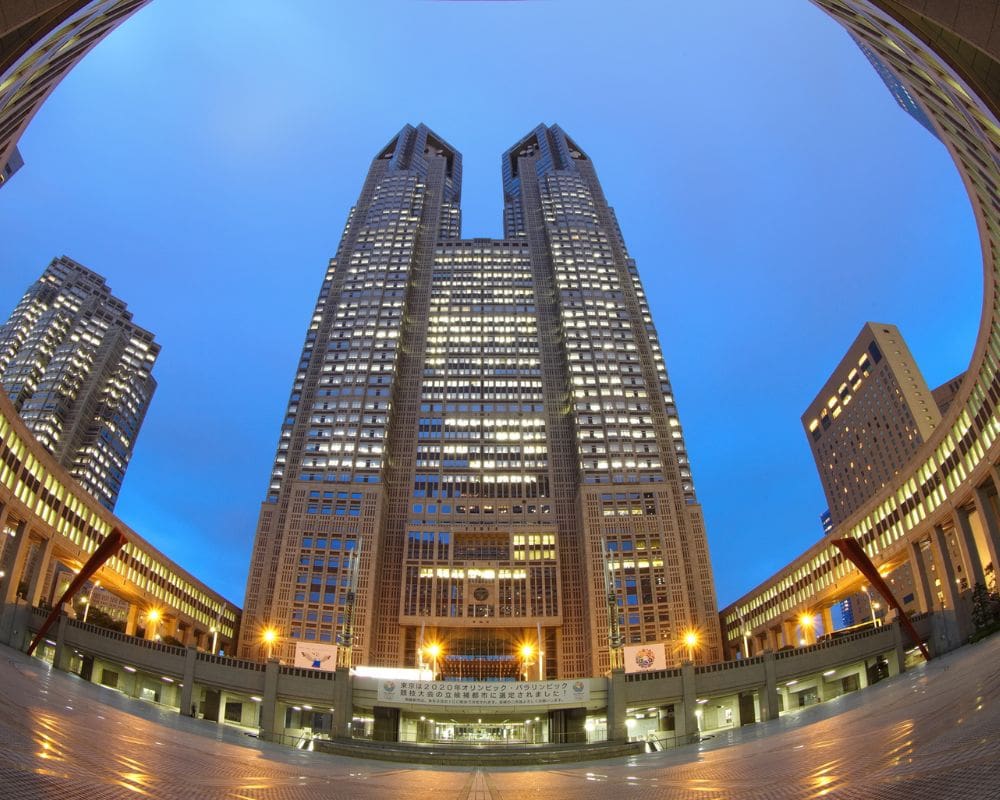
The Tokyo Metropolitan Government Building, located in Shinjuku, is one of the best spots in Tokyo, Japan, to enjoy panoramic views of the city without an entrance fee.
The building’s two towers each house an observatory at 202 meters high, offering sweeping vistas of Tokyo’s skyline, including landmarks like Tokyo Tower, Tokyo Skytree, and on clear days, Mount Fuji.
The observatories also feature cafes and souvenir shops, making it a comfortable place to relax and take in the views. The building is a short walk from Tochomae Station on the Oedo Subway Line, with additional access from Shinjuku Station via a 10-minute walk.
Entry to the observatories is free, providing an affordable option for enjoying Tokyo’s skyline. The observatories are open until late in the evening, offering the chance to see the city by both day and night.
Visiting the Tokyo Metropolitan Government Building observatories is worth it for the stunning 360-degree views and the opportunity to see Tokyo from above. It’s a must-do for photographers and anyone looking to get a sense of the city’s vast scale.
26. Explore the Historic Yanaka District

The Yanaka district is one of the few areas in Tokyo, Japan, that has preserved the atmosphere of the old shitamachi (downtown area), making it a charming place to explore for those interested in the city’s history and traditional culture.
Yanaka is known for its narrow streets, traditional wooden houses, artisan shops, and a sense of community that offers a glimpse into Tokyo’s past. The area is also home to Yanaka Cemetery, a peaceful and scenic spot famous for its cherry blossoms in spring.
Yanaka is easily accessible from Nippori Station, served by JR lines and the Keisei Line, making it a convenient stop for travelers.
Exploring Yanaka is free, and visitors can enjoy a leisurely stroll through its streets, visit local temples and shrines, and shop for crafts and snacks in the Yanaka Ginza shopping street.
Yanaka district is worth it for the opportunity to experience a slower pace of life and the traditional charm of Tokyo. It’s a refreshing contrast to the city’s more modern and bustling areas.
🥷 Travel Tip: Visit during the late afternoon when you can enjoy the golden light of sunset. This timing also coincides with many local shops and cafes being open.
27. Visit the Kabukiza Theatre in Ginza for a Traditional Kabuki Performance
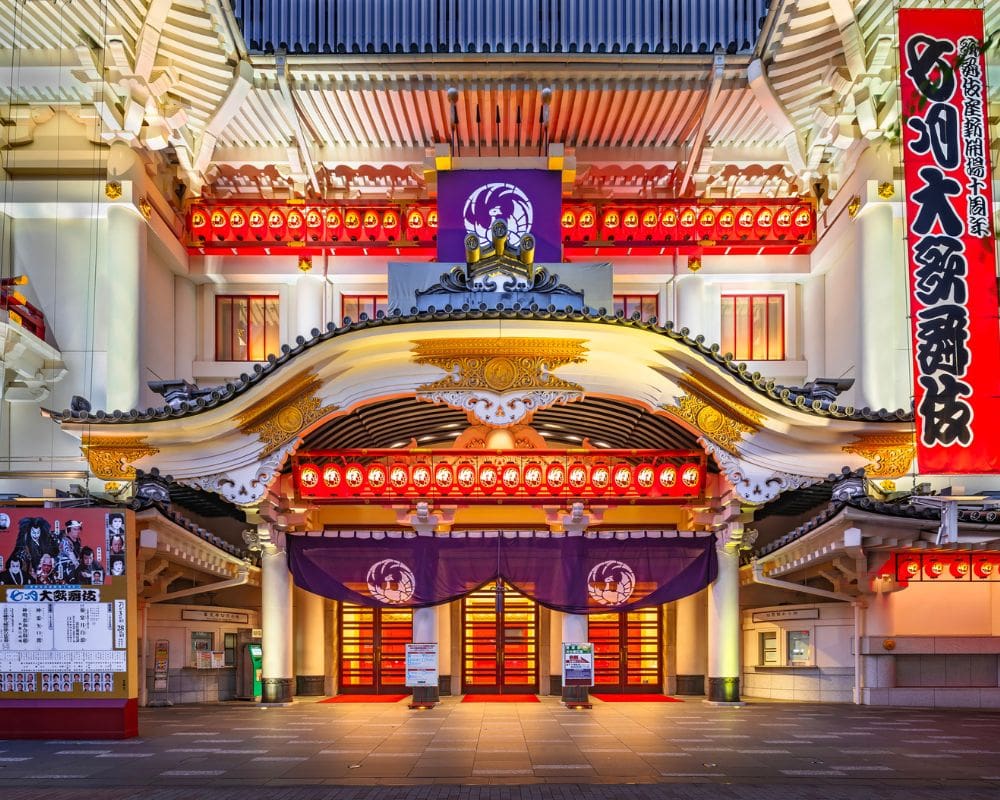
The Kabukiza Theatre in Ginza is the premier venue in Tokyo, Japan, to experience Kabuki, a traditional Japanese performing art known for its elaborate costumes, stylized performances, and unique makeup.
The theatre itself is an architectural marvel, combining modern construction with traditional design elements. Watching a Kabuki performance at Kabukiza offers a deep dive into Japanese culture and arts, making it a must-do for cultural enthusiasts.
The Kabukiza Theatre is conveniently located in the Ginza district, accessible via the Higashi-Ginza Station on the Tokyo Metro Hibiya and Asakusa Lines.
Tickets for performances can vary widely in price, depending on the seats and the length of the program. For those unable to commit to a full performance, single-act tickets are available at a reduced rate.
Visiting the Kabukiza Theatre is worth it for the opportunity to witness a centuries-old art form that continues to captivate audiences with its drama, music, and dance. The performances are a feast for the senses and offer insight into the narrative and aesthetic traditions of Japan.
👂 Travel Tip: Rent an English audio guide. This guide provides valuable context and translations of the dialogue and lyrics.
28. Take a Day Trip to the Nikko Toshogu Shrine
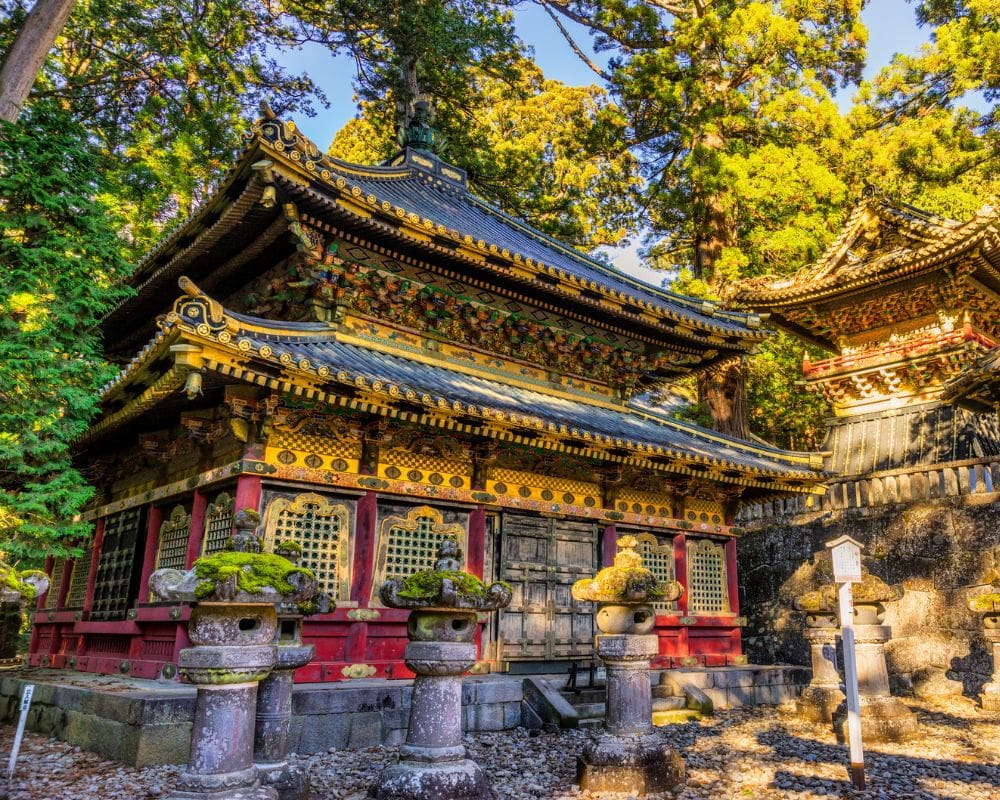
A day trip to the Nikko Toshogu Shrine is one of the most rewarding things to do in Tokyo, Japan, for those looking to explore beyond the city’s limits.
This UNESCO World Heritage site is nestled in the lush mountains of Nikko and serves as the final resting place of Tokugawa Ieyasu, the founder of the Tokugawa shogunate.
The shrine complex is renowned for its opulent decorations, intricate carvings, and stunning architecture, embodying the lavish Edo period aesthetic.
Nikko is accessible by train from Tokyo, with the most straightforward route being the direct Tobu Railway from Asakusa to Nikko, which takes around two hours.
Entrance fees to the shrine are required, but they afford access to a vast array of cultural treasures and beautifully landscaped grounds.
Visiting Nikko Toshogu Shrine is worth it for its historical significance and the breathtaking beauty of its structures and surrounding nature. It’s a place where visitors can immerse themselves in the tranquility and grandeur of Japan’s spiritual heritage.
🏞️ Travel Tip: Explore the surrounding national park areas, such as the scenic Lake Chuzenji and Kegon Falls. These natural wonders complement the cultural visit to Toshogu.
29. Visit the Sunshine Aquarium in Ikebukuro
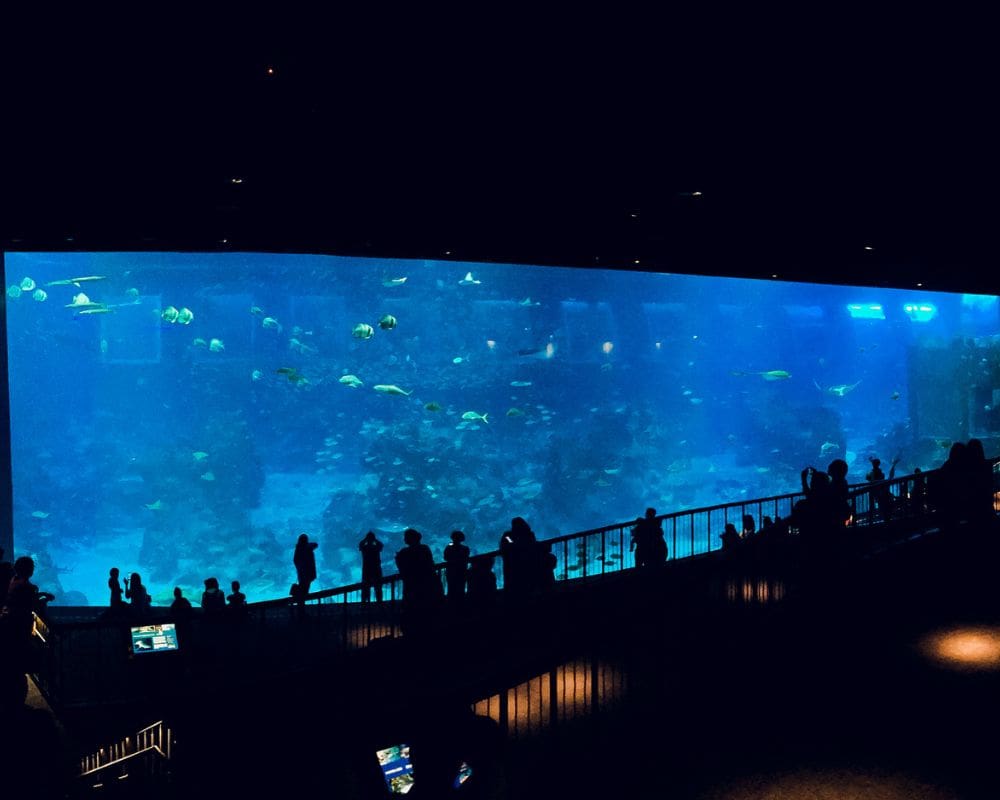
The Sunshine Aquarium, located atop a city building in Ikebukuro, offers a unique oasis in the middle of Tokyo, Japan. This innovative and interactive aquarium is home to a wide variety of marine life from around the world, including deep-sea creatures, tropical fish, and penguins.
The aquarium’s highlight is the outdoor marine garden, where seals and penguins can be seen swimming in an overhead tank, creating the illusion that they are flying through the sky.
The aquarium is easily accessible from Ikebukuro Station, a major hub served by several JR and Tokyo Metro lines.
Admission fees are reasonable, making it an affordable family-friendly activity. The aquarium features numerous exhibits and daily shows, providing entertainment and education for visitors of all ages.
Visiting the Sunshine Aquarium is worth it for the chance to escape the urban environment and immerse yourself in the fascinating world of marine life. The aquarium’s unique design and interactive exhibits offer a memorable experience that contrasts with the typical city attractions.
🎏 Travel Tip: Visit during feeding times or show times for more interactions. This is best enjoyed by families traveling with kids to Tokyo.
30. Explore the Nakamise Shopping Street in Asakusa
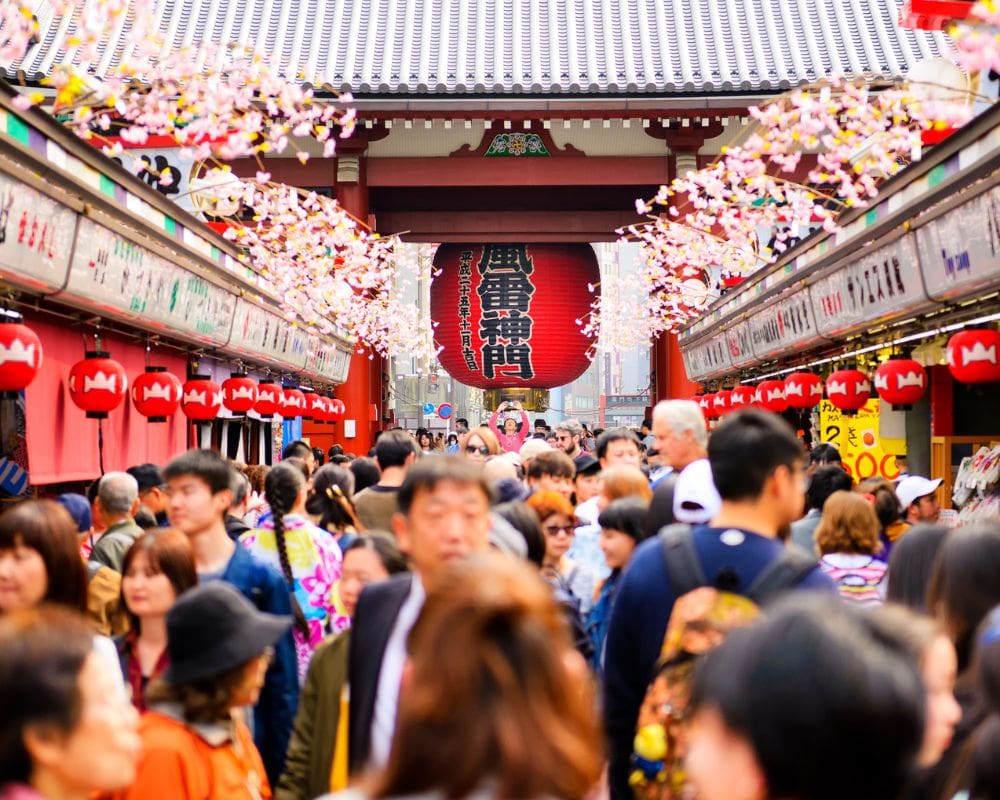
Nakamise Shopping Street, leading up to the historic Senso-ji Temple in Asakusa, is one of the best places in Tokyo, Japan, for experiencing traditional Japanese culture and shopping.
This bustling pedestrian street is lined with stalls and shops selling a variety of Japanese souvenirs, snacks, and handicrafts.
From traditional fans and yukata to delicious street food like senbei (rice crackers) and taiyaki (fish-shaped cakes), Nakamise offers a vibrant shopping experience in one of Tokyo’s most scenic areas.
The street is easily accessible from Asakusa Station, which is served by the Ginza and Asakusa Subway Lines. There’s no entrance fee to stroll through Nakamise Street, making it a budget-friendly way to enjoy the atmosphere and pick up unique Japanese gifts and snacks.
Exploring Nakamise Shopping Street is worth it for the lively atmosphere, the variety of traditional and modern Japanese goods, and the opportunity to enjoy local street food. It’s an integral part of the Asakusa visit, combining shopping with cultural exploration.
🥷 Travel Tip: Venture beyond the main path and explore the side streets and alleys of Asakusa. These areas often hide lesser-known shops, cafes, and restaurants that offer a more authentic and less crowded experience.

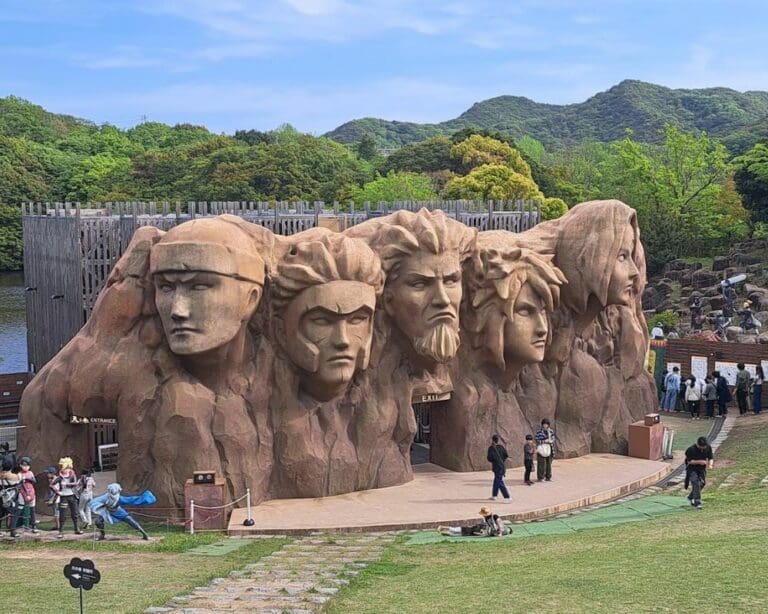
![35 amazing things to do in Harajuku Tokyo [with Harajuku map!]](https://b3461660.smushcdn.com/3461660/wp-content/uploads/2024/02/Shop-for-Kawaii-outfits-at-Laforet-Harajuku-768x614.jpg?lossy=2&strip=1&webp=1)

